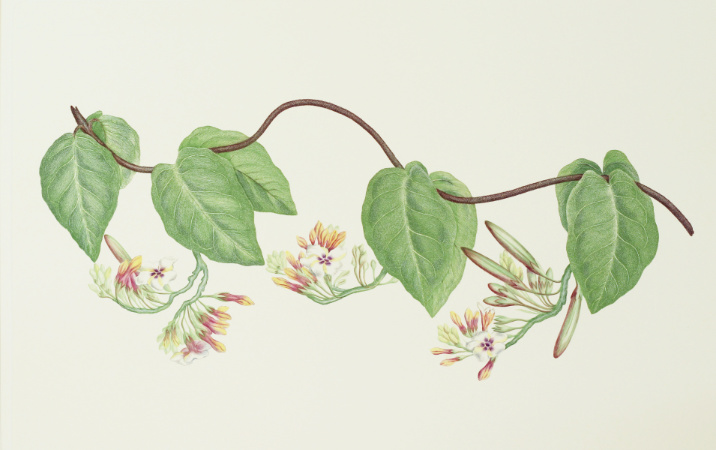
PARKINSON, Sydney (artist).
SYDNEY PARKINSON (artist)
‘Plate 348. Temnadenia Violacea (Vellozo) Miers, Echites pubescens (Apocynaceae)’
London: Alecto Historical Editions in association with the British Museum (Natural History), 1980-1990
Engraving by Charles White, printed à la poupée by Alecto Historical Editions
Limited to 116 impressions, this no. 3 of 3 for exhibition and numbered ‘EP 3/3’
£510
❧ TEMNADENIA VIOLACEA (VELLOZO) MIERS, ECHITES PUBESCENS (APOCYNACEAE)
Species discovered at Rio de Janeiro, Brazil
13 November – 7 December 1768
After setting off from Plymouth, barring a stop for supplies, South America offered the first opportunity for exploration to the crew onboard HMB Endeavour. But although Joseph Banks and his colleague, the Swedish naturalist and pupil of Linnaeus Daniel Solander, had been looking forward to reaching South America, landings on the continent were few, and that at Rio de Janeiro in November/ December 1768 was particularly disappointing. The viceroy confined most of the expedition members to their ship and generally obstructed forays into the country by shifting the boundaries of forbidden areas on a daily basis. Cook complained that it was impossible for him to take full observations from the ship for an accurate survey of the coastline.
Once Banks and his team were allowed brief forays into Brazil, the climate and perishability of plants would have prompted them to quick action. It fell to the young Scottish natural history artist Sydney Parkinson to sketch the botanical finds as soon as possible, to record them while the plants – and his visual memory of them – were still fresh. ‘In all, despite so many difficulties, this Brazilian stay yielded some 300 species, of which Parkinson portrayed 35’ (Stearn, ‘A Royal Society Appointment’, p. 98).
Among the species previously unknown to science that Banks discovered in the coastal forests of Brazil was this vine, Temnadenia Violacea. It was reported that ‘the residents [of the valley of the São Francisco river’, from which its common name derives, ‘use the kapok-like fibre from the seed capsules to stuff their pillows’, while the ‘reddish stems and leaves . . . are velvety on both sides’ (Edwin Arnold Menninger, Flowering Vines of the World: An Encyclopedia of Climbing Plants (New York, 1970), p. 86)).
SPECIFICATIONS
The engravings are all of a very similar size, with platemarks of circa 457 x 305mm, and are printed on acid-free Somerset mould-made 300gsm paper manufactured by the Inveresk Paper Company. Each sheet is watermarked ‘AHE’, measures 724 x 556mm, and bears blind embossed stamps incorporating the publishers’ and printer’s chops, the copyright symbol, and date of publication; the initials of the individual printer, the plate number, and the edition number are recorded in pencil. The engravings are protected by a bifolium of acid-free Somerset mould-made 300gsm paper, cut to form a window mount on which is recorded the modern and Banksian names of the plant, the location and date of its collection and the name(s) of the artist and engraver.
This print accompanied by a certificate of limitation.
This print is no longer available.
© Type & Forme and Alecto Historical Editions/Trustees of the Natural History Museum 2020

